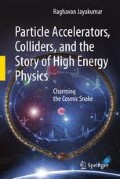Abstract
In the Lotus posture of Yoga, as in praying posture in other religions, where oneness with the Universe is the goal, one sits in a symmetric posture and fixes the mind on nothingness or oneness. Symmetries are deemed to be “principles of simplicity.” This is symbolic of the deep human understanding and intuition that a disturbance of symmetry creates action and makes us take note of the diversity of the world around us. Quantum mechanics and eastern thought even indicate that reality is created when we break symmetry and apply our senses and sensors. But beyond this heuristic appreciation of symmetry, we are aware that breaking symmetry is also what we see as part of the beauty in our world. Although leaves on a tree are identical, they are so only to a point. They are slightly asymmetric and slightly different from each other creating the rich mosaic of diverse tree leaves and branches which make up the beautiful tree. So it is with particle physics, it is well understood that if everything was symmetric in the physical description of the Universe, the Universe would be a quiet place in silent repose, like the Hindu God, Narayana in His Ocean of milk. While some of this symmetry is evident in very understandable ways, most of the symmetry that underlies the rich diversity of particles, forces and fields can only be seen in mathematical terms, and are revealed through physical laws. Yet, breaking or violation of these symmetries is also the reason for the myriad phenomena and forms of matter. Since the 1960s, there have been extraordinary developments in theoretical physics, some beyond the grasp of even reasonably trained mathematicians and physicists. But, a minimum conceptual understanding of the symmetries and associated forces controlling particle behavior can be garnered to understand these extraordinary developments. Such an understanding is valuable in appreciating the need for the modern day colliders and detectors.
Access this chapter
Tax calculation will be finalised at checkout
Purchases are for personal use only
Author information
Authors and Affiliations
Corresponding author
Rights and permissions
Copyright information
© 2012 Springer-Verlag Berlin Heidelberg
About this chapter
Cite this chapter
Jayakumar, R. (2012). The Lotus Posture, Symmetry, Gauge Theories, and the Standard Model. In: Particle Accelerators, Colliders, and the Story of High Energy Physics. Springer, Berlin, Heidelberg. https://doi.org/10.1007/978-3-642-22064-7_10
Download citation
DOI: https://doi.org/10.1007/978-3-642-22064-7_10
Published:
Publisher Name: Springer, Berlin, Heidelberg
Print ISBN: 978-3-642-22063-0
Online ISBN: 978-3-642-22064-7
eBook Packages: Physics and AstronomyPhysics and Astronomy (R0)

